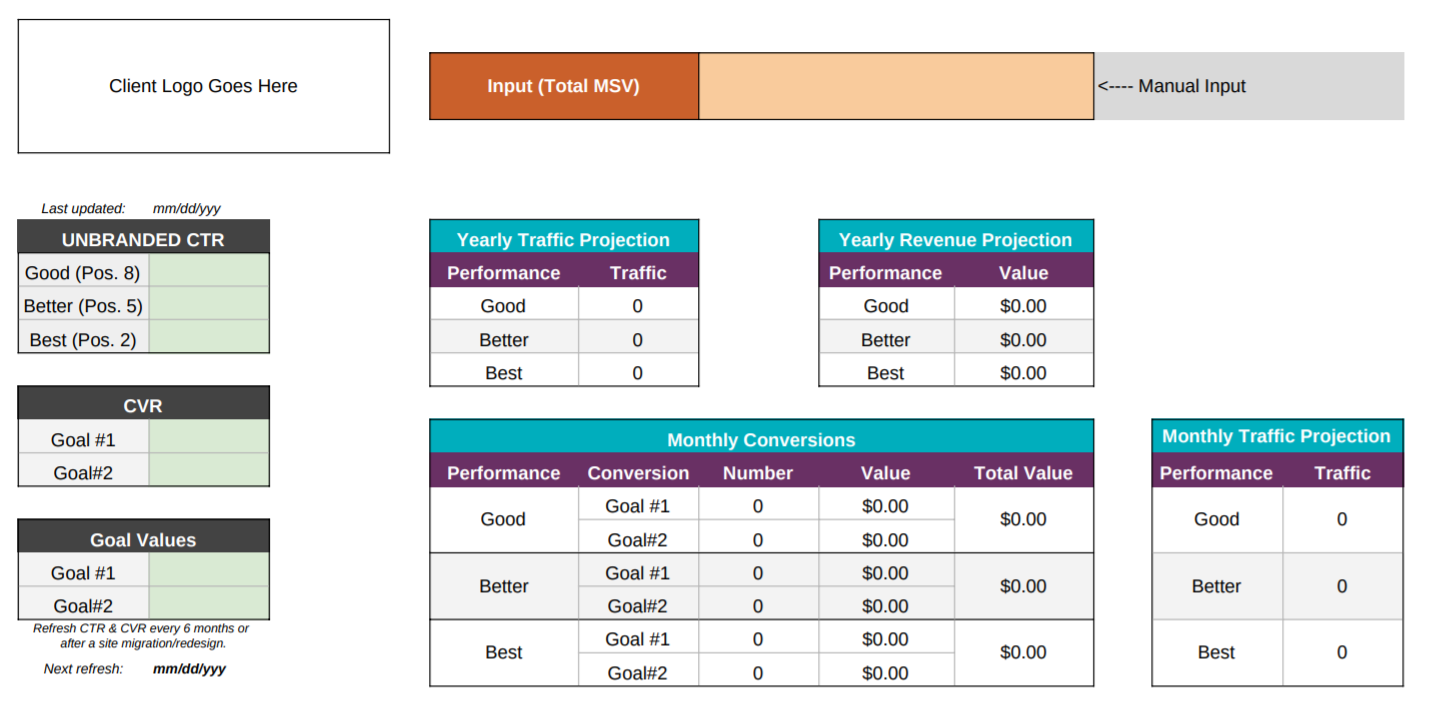What Does ROI Mean for SEO?
Return on Investment (ROI) is a metric used to judge the success of an SEO strategy based on the estimated return of the initial investment or cost to push it live.
When estimating the performance of SEO, search volume and Organic traffic is always a great leading indicator; however, at the end of the day, it’s revenue that is the true measure of success.
Showing potential ROI of SEO is incredibly important when trying to convince or communicate the value of SEO to a client, internally, or your higher-ups why they should implement a recommendation or invest in your proposed strategy.
How Do You Calculate the ROI of SEO?
We have an internal SEO ROI Calculator that we use for all accounts across Seer. This streamlines our process and helps us determine the estimated value for our SEO opportunities. However, you don’t need a fancy calculator to estimate ROI, just some important metrics and formulas which we’ll review below.
The good news? Once you know what metrics and formulas you need, creating your own SEO ROI calculator will be a breeze!
1. Find out Your Average Click Through Rate by Position
Here at Seer, we use Big Data. Using PowerBI’s data visualization software, we calculate average CTR (branded and unbranded) by position in order to get a ‘good (position 8), better (position 5), best (position 2)’ scenario for rankings.
Are you going to rank on the first page across the board? Of course not. We all know that rankings fluctuate consistently and some keywords will perform better and worse than others. However, these estimates provide guidelines on what we can expect for each ranking bucket.
When using CTRs, make sure to refresh your data at least every 6 months as well as after a site migration/redesign to ensure your calculations are as accurate and up-to-date as possible.
2. Pull Your Conversion Rates for Each Analytics Goal
Using Google Analytics, identify the conversion rate for each goal (revenue, newsletter signups, form submissions, etc.) that you’re measuring for SEO performance. Ideally, when referring to conversion rates, 3-6 months of historical data should be used.
3. Identify the Value ($) of Each Conversion Goal
It incredibly important to assign value to goals in analytics. Without an estimated value for each conversion you’re tracking, it’s impossible to estimate the ROI of any marketing initiatives on your site.
Don’t have a dollar value assigned to your SEO goals? See below for tips on finding that number.
4. Estimate Traffic and Revenue based on Search Volume
Once you have CTR, CVR, and goal value, you’re all set to start estimating ROI based on search volume opportunity. The formula to do this is:
((Total MSV * CTR) * CVR)) * Goal Value = Estimated SEO Revenue per Month
Want to estimate the total revenue over a year? Just multiply this number by 12 and you’re set!
5. Calculate the Estimated SEO ROI
At the end of the day, ROI is the return of the investment divided by the cost of the investment. To DIY, you can plug and play the following formula:
(Estimated SEO Revenue per Month - Cost to Implement Strategy) / Cost to Implement Strategy * 100 = SEO ROI
Let’s Try Calculating SEO ROI With an Example
Scenario:
Say you identify the opportunity to create a content asset that targets keywords receiving a combined 12,500 searches a month.
Estimating Organic Traffic:
Due to the competitive market, you estimate that this piece can achieve an average ranking of 5 for each keyword. By analyzing the data in Google Search Console, you determine that the average CTR for unbranded keywords at position 5 is 6%.
With just these two metrics, you can make a rough estimate on how much Organic traffic this asset will receive each month at an average rank of 5:
12,500 * .06 = 750 organic sessions
Calculating Revenue for Conversions:
The main goal of this content asset is to drive form fills, which have a value of $45 per completed form. In Analytics, you determine that over the past 6 months, your Organic conversion rate for form fills was 5.3%.
Knowing that you’re estimating the asset to drive 750 Organic sessions a month, you can now calculate how many form fills those Organic visitors will complete:
750 * .053 = 40 form fills
With 40 form fills at a value of $45, this content asset is estimated to drive a total value of $1,799 a month.
Using the SEO ROI Formula:
Say this asset will cost ~$500 to get it live on the site. To measure the SEO ROI for just one month of performance, the calculation would be:
((1799 - 500) / 500) * 100 = 259%
Additionally, we all know that SEO performance grows over time, so even a year's worth of revenue from this asset would be a great return on the initial investment.
How to Find the Dollar Value of Your Conversions
We get it, not everyone works in ecommerce, automatically knows the value of their conversions, or has them set up as goals in analytics. For clients of ours who don’t know the value of a conversion, we typically try get an estimate or ballpark number by digging in a little deeper and asking questions like
- If you had to guess at what a lead or conversion would be worth - would it be closer to $100, $1,000, $100,000? More? Less?
From there you can begin to narrow it down to a number that gives you and the team a better idea of value.




